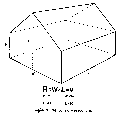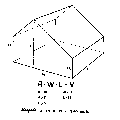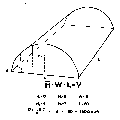Introduction Management of Insects and Related Pests
Horticulturists estimate that 1,500 varieties of herbaceous ornamental plants are grown commercially in North Carolina. Ornamentals are grown in commercial greenhouses, commercial fields, professionally maintained landscapes, interior plantscapes, and home grounds, as well as inside homes or in hobby greenhouses. An amazing variety of insects feed on flowering and foliage plants. Many field, fruit, and vegetable crop pests such as the cabbage looper, corn earworm, diamondback moth, and oblique banded leafroller also feed on ornamentals. Lush growth and sheltered growing conditions make ornamental herbs especially attractive to plant pests. The routine use of insecticides usually eliminates predaceous insects and mites. However, pests remaining after treatment sometimes tolerate commonly used insecticides. To stay in business, most commercial flower and foliage plant growers must become fairly sophisticated in using various types of pest management practices, insecticide formulations, application equipment, and in rotating insecticides from one chemical group to another. Commercial growers use a battery of general and restricted-use pesticides. Although amateur gardeners battle the same pests, the most effective chemicals for control are often very expensive or are restricted so that homeowners are not allowed to use them. This puts a moral burden on the commercial grower to try earnestly to eliminate all plant pests from bedding, potted, and cut plants before selling them. Keys to adults and immatures of the pests referred to above are included in this publication following the next section on "Management of Insect and Related Pests." These keys, plus the color plates and the illustrations in the insect notes, will help you to identify the pests of herbaceous ornamental plants. Identification is important to assure proper control measures. Management of Insect and Related Pests This manual is designed to augment state Cooperative Extension Service publications on pest management, not to duplicate them. In no way are the suggestions for safe use and calibrations for proper application in the state Cooperative Extension Service recommendations to be belittled or ignored. This section on management should be viewed as an expansion of explanations begun in those publications. Greenhouse Chemical Control--Total reliance on pesticides for pest management is labor intensive and sometimes very hard on the plants. Although there are numerous practical and philosophical problems with the chemical control of insect and mite pests in the greenhouse, pesticides will remain important in greenhouse pest management at least for the next few years. Control of pests in the greenhouse is often difficult because of lush, sheltered growing conditions. In general, insects, mites, and slugs reproduce more rapidly in warmer temperatures. Also, periodic use of pesticides in greenhouses often reduces parasites and predators of greenhouse pests because the pests tend to be more resistant to pesticides than their predators and parasites. Application of pesticides is almost essential if one is to stay in the greenhouse profession. Eliminating weeds inside and outside the greenhouse reduces alternate hosts for ornamental plant pests. Screen doors and vents make it harder for moths and beetles to fly in and lay eggs or feed. But, careful as the grower may be, sooner or later an insect or mite will come in on the clothes of workers, on cuttings, in pots, or in soil. Many growers apply pesticides periodically as "insurance" against accidental infestations. Despite these precautions, however, insects or other pests may become established. Some growers treat whenever they discover pests. Growers should survey the plants on a daily or every-other-day basis to guard against extensive damage by insects, mites, or slugs. Pesticides are applied in greenhouses in almost every conceivable manner. Legal methods are usually the safest! Growers use aerosols, mists, smokes, fogs, dusts, sprays, drenches, and granules--everything but aerial application and backrubs. Aerosols, smokes, mists, and fogs must be applied when the greenhouse is closed (at night or in the winter). Since most pesticides are sensitive to ultraviolet rays, treatments made later in the evening will be more effective. After the waiting period specified on the label has passed, the structure must be well ventilated before workers can safely enter. Fogs, smokes, and aerosols are generally applied on a cubic-foot basis. Compute cubic feet by multiplying the area of the floor times the average height of the roof: that is, the length times the width times the average height (Fig. 1). For houses with flat, sloping roofs, add the height at the eave to the height at the highest part, divide by 2, and multiply by the area of the floor. For houses with rounded roofs, measure the highest point in the middle and at 1/4, , and 3/4 of the distance to the low point. Add these 4 measurements, divide by 4, multiply by the area of the floor, and you have a pretty close estimate of the volume of the house. (Although this estimate is a little low, rounded roof houses are usually covered with polyethylene film and are consequently very tight. Thus, applications in these houses do not dissipate as rapidly as applications in fiberglass or glass houses.) Fogs, smokes, and aerosols generally need to be diluted by the air in the greenhouse to avoid damage to the plants. Place smoke fumigators so that the smoke does not vent directly onto the plant foliage. Growers customarily wear self-contained breathing systems or gas masks when applying fogs, smokes, or aerosols. Some growers who use smoke fumigators determine the number of fumigators needed, based on cubic feet, and light those furthest from the door first. This allows the grower to vacate the house before it becomes dangerously filled with fumes. Two people should always be present when applying toxic substances in the greenhouse. If one person gets accidentally poisoned, the other can drag the victim to safety and call for help. Dusts and sprays are applied with conventional dusting or spraying equipment. Necessary safety clothing must be worn. Apply granular insecticides with a handheld shaker or some other device that does not grind up the granules. Wear boots, long pants, a long sleeved shirt, rubber gloves, and a respirator. The plants and potting mix should not be handled until the granular pesticide has been washed from the foliage and watered in thoroughly. Figures 1a, b, c, d - Click image for larger view.
Integrated Pest Management IPM uses all suitable methods to reduce insect and mite populations to the lowest acceptable level. IPM is a complex program as each crop must be considered individually. However, there are a number of basic practices that apply to most greenhouse crops. Clothing: An effort should be made to avoid carrying in- sects into the greenhouse by wearing clothes that are brown, red or black. Do not wear white, yellow, or green, as these colors are attractive to aphids, thrips, whiteflies, leafminers, and darkwinged fungus gnats. Light to dark blues also are attractive to aphids and thrips. Quarantine: Before any plant material is brought into the greenhouse, it should be thoroughly inspected for insects, mites, and diseases. Furthermore, new plant material should be kept in a separate section for a week or more before such material is incorporated into the production area. Such highly resistant pests as the green peach aphid, western flower thrips, and silverleaf whitefly move readily on plant material. The swapping of insects, mites, and diseases on infested plant material is without doubt the major way resistant thrips, aphids, and whiteflies are transported throughout the greenhouse industry. Screening: In an experiment with greenhouse screening in California, a crop of chrysanthemums was grown successfully without a single application of pesticides. Exclusion demonstrations at North Carolina State University with the western flower thrips and the silverleaf whitefly have shown that both pests can be significantly excluded by spunbonded and perforated polyethylene screening. With screening, the finer the mesh, the greater is the tendency to restrict air flow into the greenhouse. Polyspun materials cut air flow by a factor of two. The perforated polyethylene screening cut air volume by a factor of five. Although the pore sizes of some screening materials are large enough that the thrips are capable of wedging through, the screening still excludes many thrips. Evidently, these materials are not recognized by thrips as a suitable substrate to feed on. When the thrips probes the screening it may instinctively resume flight searching for a suitable plant. Pest Recognition: For proper management, it is important to be able to recognize the various kinds of pests in their various stages of development. Probably the most frequently misidentified pests are shore flies and darkwinged fungus gnats. Shore flies are of little economic consequence in the greenhouse but are very resistant to pesticides. Thus a grower can waste effort and pesticides trying to chemically control shore flies rather than trying to control algae the shore flies are breeding in. Another example of misidentification is the assumption that parasitized green peach aphids are some sort of new 'tan' aphid. Parasitized aphids adhere to the plant fairly tightly, so in spite of repeated applications, these tan' aphids seem to be impossible to kill. Monitoring: Constant vigilance for insects, mites, and diseases is required for effective pest management. An employee or certain employees should be assigned the responsibility of scouting for insects and other pests on a regular basis (perhaps weekly during the winter and twice weekly during the summer). Written records of where various pests are found should be kept. Pests can be monitored by using yellow and blue sticky cards, by using yellow pan traps, and by examining the foliage, flowers, and occasionally the roots. Light traps outside can be used to monitor for European corn borer, corn earworm, and beet armyworm adults. Record Keeping: A written log should be kept of pest type, locality, abundance, and all pesticides applied. Such records can be of long-term benefit as many pests tend to appear at about the same time each year. However, the short-term benefits of written records may be greater. Knowing what pests survive a pesticide application alerts the grower to the possibility of poor timing, poor application, or pesticide resistance in the pest population. A change in strategy, application technology, or type of pesticide can be made before the crops are significantly damaged. Biological Control: Some growers use beneficial organisms for biological control where appropriate. Unfortunately, there are no really effective organisms available for managing the silverleaf whitefly or the western flower thrips. Encarsia formosa parasitic wasps infest silverleaf whiteflies to some degree and Amblyseius predatory mites, used for spider mite suppression, can feed on thrips. Bacterial and nematode organisms can be readily integrated into a traditional pest management scheme, whereas others require a fairly high level of management. Aphytis wasps, Aphidoletes maggots, and green lacewings are available for aphid suppression. Bacillus thuringiensis kurstaki pesticides are available for caterpillars. Bacillus thuringiensis israelensis and Steinernema carpocapsae nematodes suppress darkwinged fungus gnats. Cryptolaemus and Delphastus lady beetles (when available) can be used for mealybugs and whiteflies. Parasitic wasps are available for soft scale management and predaceous mites are available for spider mite suppression. Encarsia formosa parasitic wasps can be used especially for greenhouse whitefly suppression. Except for Bacillus thuringiensis pesticides, the use of biological organisms is usually not compatible with the use of chemical sprays. It is possible to integrate sprays of soaps and oils with Encarsia formosa by timing pesticide applications to coincide with the "black scale stage" of the parasite's development. Also the "brown mummy" stage of aphids infected with Aphytis wasps are resistant to soaps and oils. Organic Control--Organic growers tend to be wary of relying on pesticides for routine pest management. Most organic growers are highly receptive to the basic integrated pest management practices (screening, biological control, and monitoring). The range of chemicals organic growers can use is limited to those that are certified to be "organic" by various organizations such as the California Certified Organic Farmers. Some of these chemicals work well and others are marginally effective. Finding formulations that are certified as organic and that are actually labeled for greenhouse use is sometimes a problem. Some organic growers in North Carolina use screening to exclude pests and methods such as irrigation to dislodge and destroy mites and aphids or washing the produce by hand at harvest to remove pests. Organic Chemicals: Soaps, oils, and nicotine sulfate can be used for aphid suppression. Soaps, oils, neem extracts, and pyrethrum sprays and aerosols are moderately toxic to 3 whiteflies. The Bacillus thuringienses kurstaki pesticides and pyrethrum sprays, and aerosols are effective for caterpillar control. Soaps and pyrethrum pesticides suppress mealybugs. Spider mites are susceptible to soaps and oils. Pyrethrum sprays and aerosols help suppress thrips. Commercial Indoor Landscape Commercial indoor landscape accounts are perhaps the most difficult areas in which to attempt pest control. Interior plantscapes extend from public conservatories to extensive plantings in homes, hotels, office buildings, restaurants, shopping malls, hospitals, schools, and other environmentally sensitive areas. The use of insecticides in many of these areas is often greatly restricted because of the sensitivity of the surroundings. In addition, few chemicals are cleared for ornamental plant use in public areas, and public prejudice against pesticide odors can prevent application of pesticides in many situations. The first line of defense against ornamental plant pests is sanitation and quarantine. Taking steps to prevent pest problems is well worth the effort. Inspect plants thoroughly and only place insect-free plants into an indoor landscape. If possible, when insect infestations are first found, isolate infested plants to prevent spread of the infestation. Interest in biological control in indoor landscapes has expanded in recent years because of restrictions placed on interior plantscape pesticide application, pesticide costs, poor control with pesticide products, phytotoxicity, and potential human health hazards. To be successful at managing pest problems with biological control agents requires a knowledge of the biology of the pest species, the biological control agent(s), and a great deal of time and commitment. Biological control systems do not look after themselves. Thorough, timely applications of properly labeled pesticides are another important aspect of an integrated pest control program. Rotating infested plants back into a greenhouse where they can be treated thoroughly and revived in vigor before being returned to the indoor landscape is a sound practice but is often not practical. Treat commercial landscape areas at night, on weekends, or when a minimum number of people are present. The public should not be allowed in the vicinity of treated plants until the pesticide residue on the foliage has dried completely. Commercial Field Grown Flowers This is the sector of the ornamental plant industry that most closely parallels agricultural crop production in methods and equipment. Tractor-drawn spray rigs or mist blowers are often used for pest control. A broad range of chemicals is cleared for use on field-grown flowers. However, the number of insect and mite pests that can be tolerated is very low. Vigilance must be maintained to prevent extensive damage by ornamental plant insect, mite, and slug pests. Home Grounds and Home Dwellings Homeowners have difficulty in pest management of their grounds, in part due to the great diversity of ornamental plants. Homeowners are often not aware that many of these plants have insect and mite pests. Injury caused by insects and related pests is another source of potential confusion if the insect or mite is not available to help in the diagnosis. When they are willing to educate themselves to recognize problems and to frequently inspect their ornamentals, homeowners can limit the number and scope of their pest problems. Home gardeners have an adequate selection of pesticides labeled for home use, especially for home ornamentals. A variety of application equipment options are available to the amateur gardener. Probably the two most popular applicators are dusters and hose-end sprayers. Dusts require no mixing and are often applied directly from the purchased container, which has a perforated top. Plunger dusters and bulb dusters are still in use, but not as popular. These types have a reservoir that is filled with the dust. Dusts offer quick and convenient application, but are best applied when there is little wind to reduce drift. Hose-end sprayers use water pressure to siphon, dilute, and deliver the pesticide to its destination. Pesticide concentrate is placed in the reservoir of the hose-end sprayer and water added based on the volume of spray needed. Length of hose limits use of hose-end sprayers on large properties. The hose-end sprayer reservoir must be rinsed after each use. Compressed air sprayers are available in several sizes and prices and are popular in the home garden. These sprayers use air pressure to deliver the diluted pesticide through the spray nozzle to the target. The nozzle is often adjustable, from a coarse to fine spray pattern. Spray coverage is more uniform with compressed air sprayers than with dusters and hose-end sprayers. Pesticides must be diluted according to label instructions, and sprayers must be cleaned after each use. Ready-to-use pesticides and sprayers are the newest application technology. Pesticides are sold premixed, and the reservoir is connected to a plastic nozzle. The system is a closed one, with no mixing or cleaning necessary. Pressure is applied by a trigger. The system is adequate for small areas, but would not provide coverage to larger plantings. Sprayers mounted on garden-type tractors similar to those available for farm use can be used on larger properties. Some models use the tractor battery to power the sprayer and others use a power-take-off system. As with other sprayers, proper mixing of pesticides and thorough cleaning of the equipment after use are required. |



